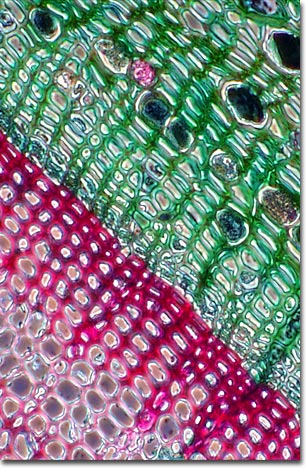Phase Contrast Image Gallery
Tracheid Cells
The photomicrograph below illustrates a stained thin section of vascular plant stem imaged with phase contrast illumination. Tracheids are nonliving cells found in the xylem of the more ancient plant types, seedless vascular plants (ferns, club mosses, and horsetails) and gymnosperms (cedar, pine, and cypress trees).

As plants moved from the aquatic realm to land, some of them developed internal vascular structures that carried water and nutrients throughout the increasingly complex plant body. Over the past 350 million years, the ability to live outside of water has enabled vascular plants to exploit a greater diversity of habitats and today they dominate most terrestrial environments.
Vascular systems are found in two major groups, the seedless vascular plants and the seed-bearing plants. Although these systems have different components amongst the different plant groups, the basic structure is the same. Xylem transports water and nutrients from the roots to the rest of the plant. Phloem carries food made in the leaves to other plant structures.
Traechids are long tubular structures having walls that are made stiff by a combination of cellulose and lignin, a chemical binder. This provides support and gives plants their characteristic woody texture. Perforations at the ends of each cell allow water and nutrients to pass through, moving these substances upward from the roots to other parts of the plants. Interestingly, tracheids don't become functional until they are dead and empty. Angiosperms, the flowering plants, have a more specialized and efficient water conducting structure, called the wood vessel or trachea, that probably evolved from the tracheid.
BACK TO THE PHASE CONTRAST GALLERY
